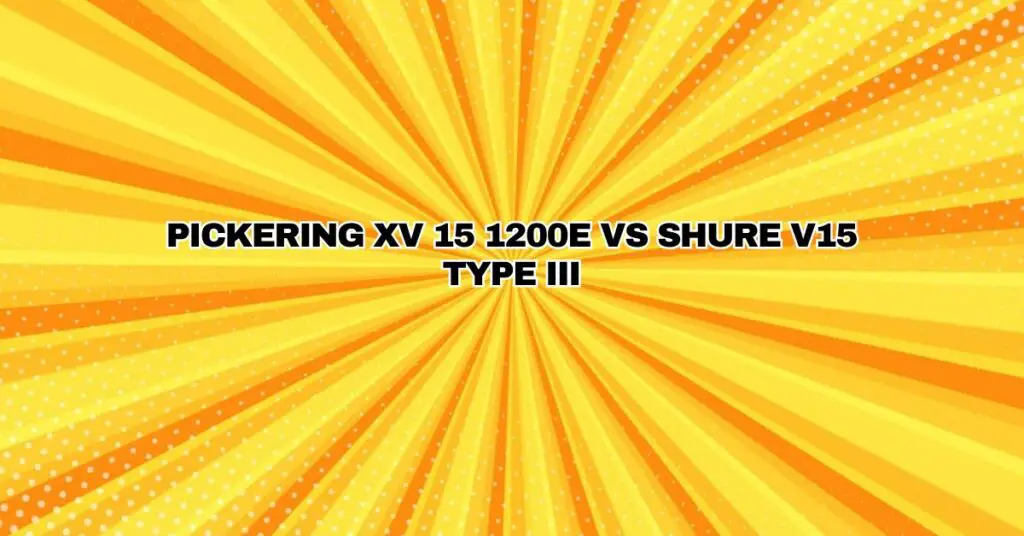In the world of phono cartridges, the Pickering XV 15 1200E and the Shure V15 Type III are two legendary contenders known for their exceptional performance and audiophile-grade sound reproduction. In this comprehensive comparison, we will dissect the similarities, differences, and unique characteristics of these iconic cartridges, helping you decide which one might be the ideal choice for your vinyl listening experience.
Pickering XV 15 1200E: A Time-Tested Gem
The Pickering XV 15 1200E, introduced in the late 1970s, is a classic phono cartridge that has earned its place in the audiophile hall of fame. Known for its remarkable tracking ability, accuracy, and sonic clarity, the XV 15 1200E has been a staple for vinyl enthusiasts for decades.
Shure V15 Type III: A Shure Classic
The Shure V15 Type III, released in the early 1980s, belongs to the revered V15 series of phono cartridges from Shure. Renowned for its precise tracking, clean sound, and superb detail retrieval, the V15 Type III is a testament to Shure’s commitment to audio quality.
Key Specifications
Before we dive into the comparison, let’s examine the key specifications of these cartridges:
Pickering XV 15 1200E:
- Stylus Shape: Elliptical
- Tracking Force: 1.0 – 1.5 grams
- Output Voltage: 5 mV
- Frequency Response: 10 Hz – 25 kHz
- Cantilever Material: Aluminum
- Compliance: Medium
Shure V15 Type III:
- Stylus Shape: Hyperelliptical
- Tracking Force: 0.75 – 1.5 grams
- Output Voltage: 3.5 mV
- Frequency Response: 15 Hz – 25 kHz
- Cantilever Material: Beryllium
- Compliance: Medium
Comparison: Pickering XV 15 1200E vs. Shure V15 Type III
Now, let’s explore a comprehensive comparison between the Pickering XV 15 1200E and Shure V15 Type III across various aspects:
- Design and Build:
- The XV 15 1200E features an elliptical stylus and an aluminum cantilever.
- The V15 Type III incorporates a hyperelliptical stylus and a beryllium cantilever.
- Both cartridges are engineered for precise tracking and long-term durability.
- Sound Quality:
- Both cartridges are celebrated for their sonic clarity, accurate detail retrieval, and clean sound.
- The V15 Type III is known for its exceptional high-frequency response, resulting in slightly crisper treble notes.
- Tracking Ability:
- Both cartridges exhibit remarkable tracking capabilities, ensuring minimal distortion and wear on your vinyl records.
- The V15 Type III is famous for its superior tracking, particularly in high-frequency passages.
- Output Voltage:
- The XV 15 1200E offers a higher output voltage of 5 mV, which may require an appropriate phono stage or preamp for optimal performance.
- The V15 Type III features a standard output voltage of 3.5 mV, suitable for most phono stages.
- Cantilever Material:
- The XV 15 1200E employs an aluminum cantilever, known for its lightweight yet sturdy construction.
- The V15 Type III features a beryllium cantilever, which is prized for its rigidity and high sonic transparency.
- Compliance:
- Both cartridges have medium compliance, ensuring compatibility with a wide range of tonearms and turntables.
Availability and Pricing:
- Both the XV 15 1200E and V15 Type III have been discontinued, making them sought-after collectibles in the vintage audio market.
- Prices for these cartridges can vary widely in the used and vintage market, influenced by condition, rarity, and collector demand.
Conclusion
The Pickering XV 15 1200E and Shure V15 Type III are exemplary phono cartridges that have earned their place in the pantheon of audio excellence. While both cartridges are known for their clean sound, accurate tracking, and detailed audio reproduction, the choice between them may come down to personal preference, system compatibility, and availability.
The XV 15 1200E and V15 Type III offer audiophiles and vinyl enthusiasts a choice between two iconic cartridges, each with its unique strengths and characteristics. Regardless of your selection, you’ll be embarking on a journey of high-fidelity vinyl playback, experiencing the enduring legacy of two giants in the world of analog audio.

